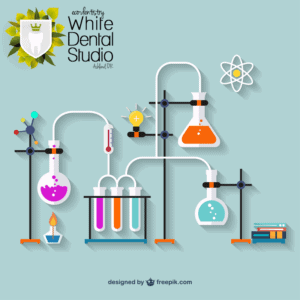 When a person thinks of a doctor, they often think of biology. While it’s true that biology is the major foundation for the medical field, it’s important to remember the roles chemistry play in medicine. Understanding chemistry is a pillar of dental comprehension which helps us to accurately and predictably achieve successful results.
When a person thinks of a doctor, they often think of biology. While it’s true that biology is the major foundation for the medical field, it’s important to remember the roles chemistry play in medicine. Understanding chemistry is a pillar of dental comprehension which helps us to accurately and predictably achieve successful results.
Over the coming months, we’ll look at the chemistry of dentistry. Don’t worry, I’ll keep it short and simple and focus on four areas: Tooth Decay, fluorides & remineralizing products, tooth whitening, and filling materials (crowns, cements, implants, dentures are for another time).
Teeth decay as a result of lactic and propandic acids produced as bacteria in our mouths feed on the sugars we supply from our diet. These acids reduce the strength of the enamel on our teeth and, with enough time and exposure to bacteria and a food source, the tooth breaks down.
We naturally have an amazing coping mechanism to overcome these ruthless attackers of teeth – saliva! Saliva acts as a buffer to reduce acidity, it provides antimicrobial enzymes, and it lubricates and improves our ability to taste. Gum disease, cavities, and other oral problems increase as salivary function decreases. If you’re wondering, a healthy person produces approximately 1 litre of saliva per day. Saliva can’t do everything, so brushing with a quality toothpaste (there are too many to count) and flossing regularly give us an upper hand on acid and the breakdown of teeth.
Which brings us to remineralization and fluorides. Fluoride ions present in toothpastes, teas, water, and other beverages we consume can help prevent tooth decay by topically accumulating on a tooth and converting the existing crystalized hydroxyapatite of tooth structure into fluorapetite – which is more resistant to acid attacks. I won’t push a fluoride-for-everyone agenda and expect by now many people understand this philosophy in our practice – we’re all capable of making decisions when provided with good information and reasonable options. This is why there are other ways of remineralization – specifically by increasing the topical availability and exposure a tooth has to calcium and phosphate and products are available to accomplish this goal for patients, age 2 to 102, who are so inclined.
Next month, we’ll touch on filling materials and whitening, but for now, I leave you with a classic chemistry riddle: Why can’t you trust an atom? They make up everything!
We always welcome new patients to our Ashland dental studio and invite you to set up an appointment with us soon. Bring us your favorite chemistry riddles and we’ll pick our favorites and share them!
***
Dr. Brandon White is the owner dentist at White Dental Studio in Ashland, OR. He is the only eco-certified dentist in Southern Oregon and one of 2 Gold certified dentists in Oregon. Find out more about our doctor!)

Recent Comments